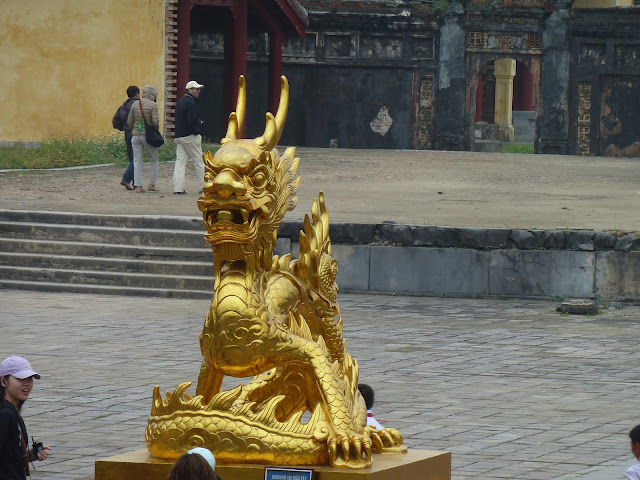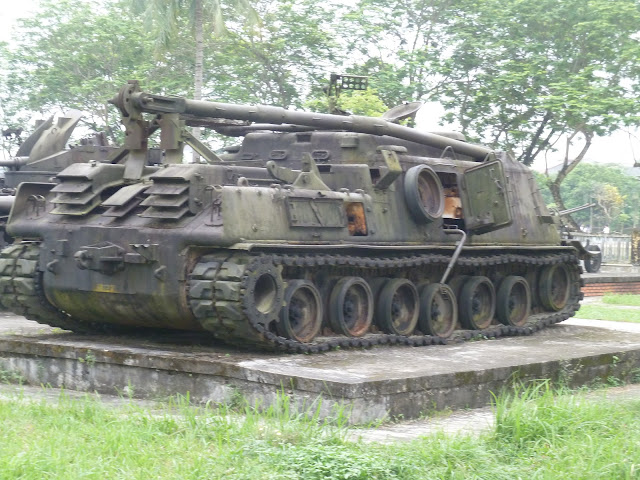Hugh Eh? is a little town about 2/3 up the 1600 long coast of Vietnam and is about 30 miles south of the original DeMilitarized Zone (DMZ) demarcating North and South Vietnam. Its a tragic place as it features in so much of Vietnam's history and was one of the key spots for me on our visit of Vietnam. It was the former Imperial Capital of Vietnam under French colonial rule and prior to that as well. If you read any of the history in my blog on South East Asia, Hue was where Emperor Boa Dai resided until he abdicated in 1945 to Ho Chi Min.
As you may have read, during WW2, Vietnam was under the control of the Vichy French and under the guidance of their axis allies, the Japanese. This meant that Vietnam was spared the Japanese occupation and Emperor Dia was allowed to reign. The American's had supported Ho Chi Min and his Viet Minh in the war against the Japanese like they did with Chairman Mao in China (but also with Chang Kai Shek and the Nationalist Chinese). In 1944 and 1945, Vietnam suffered a terrible famine and the Viet Minh encouraged the citizens to refuse to pay any taxes and they raided over 100 warehouses with rice and gave it out to the population which made them very popular.
When France was liberated from the Germans in early 1945, the Japanese no longer trusted their Vichy French administrators and rounded them up and put them in a camp for the duration of the war (in fact they didn't get out until well after the surrender). They then "suggested" that Emperor Boa Dia declare Vietnam an independent country which he did in August 1945. When the American's dropped the bombs on Hiroshima and Nagasaki that month causing the Japanese to unconditionally surrender, they really had nobody to surrender to in Vietnam as the Americans and British were no where near here so they turned it over to Ho Chi Min who filled in the power vacuum as the French administrators were still in jail.
Ho Chi Min launched the August Revolution and declared Vietnam's independence on Sept 2, 1945 just days after the end of the second world war. In a nod to the US, he modeled his speech after the US Declaration of Independence. The problem was that the Allied powers had already agreed (post Roosevelt) that Vietnam was a French colony. Since France didn't have any troops, ships, arms etc to retake Vietnam, the Allies agreed that the British would take over the south. They quickly freed the French administrators and gave them arms as well as some of the Japanese soldiers still remaining as they didn't have enough men on the ground, and the Chinese Nationalists did the same from the North.
To set the stage, China was in the middle of its civil war which lasted until 1949 when the Nationalist Chinese retreated to Taiwan. This was also when attentions were turning from the Soviets being allies against the axis powers to cold war enemies as they were swallowing up large chunks of eastern Europe.
The Soviets originally told Ho Chi Min to negotiate the turn over to the French which he did and signed a treaty in March 1946 with them that the Democratic Republic of Vietnam would be considered a "free" republic within the French Union with the specifics to be negotiated later. The French then landed in Hanoi that same month and by November had thrown out the Viet Minh beginning the first Indochina War which was to last more than a decade and end with the French leaving North and South Vietnam partitioned and a promise of elections to reunite the two countries in a few years time.
Those elections never happened, in large part because the south (and the US) felt that Ho Chi Min would win soundly. Remember, that the North looked at this like a liberation of colonization while the South was looking at it like stemming the flow of communism. The leaders in the south were very corrupt and enacted laws that ensured that most of the peasant land was owned by 2% of the population and the peasants had to pay exorbitant rents. These policies were cast by the VC and the North as a failure of capitalism and ensured wide support for the VC within the south.
Hue was the battleground where much of this would be fought. The DMZ is only about 40 Kms north of here and its status as the once National Capital ensured that the VC and NVA armies would try desperately to take it over as a symbol if nothing else. During the Tet Offensive of 1968 (I'll get into that with the DMZ visit in two subsequent blog entries), Hue was taken over by the Viet Cong and North Vietnamese Army and was held during particularly nasty fighting and bombardment for 28 days. Most of Hue was leveled and somewhere between 2000 and 6000 civilians and prisoners of war were executed by the NVA/VC and buried in mass graves.
The official explanation for that by Vietnam now is that these prisoners couldn't make the retreat so were put out of their misery but the massacre is well documented (although little talked about here for obvious reasons). The American's were said to have said at the time that they "had to destroy the city to save it". It was subjected to intensive artillery and aerial bombardment as well as hand to hand fighting in some of the bloodiest combat of the war. This is reflected in the state of the Citadel and Royal Palace grounds... most of the buildings simply do not exist any more. During and after the war, the Vietnamese looked down on these relics of the imperialistic past however in recent times they are rebuilding and have a massive celebration planned for July.
We walked around Hue a bit but the real reason we came here was to tour the DMZ and the Phong Nha and Paradise Caves that you will hear about on my next two posts. Its a likable enough city of about 1M people but the climate was very much colder (10-12 degrees C) than what we've been used to so we were all dressed up with our warmest clothes (except for Shawn, the little furnace of course).
 |
| A "Dragon Boat" which we used to cross the river in Hue and save about 3kms of walking |
 |
| You can see how cold it is in Hue! The girls in their new North Face ski jackets picked up in Luang Prabang of all places! |
 |
| The outer wall and moat of the Citadel |
 |
| Walking over the moat to one of the 4 gates to the outer walls. |
 |
| The main entrance |
 |
| Look what we found munching on the grass! |
 |
| The inner walls heading to the forbidden palaces |
 |
| The Northern Gate of the inner wall |
 |
| From outside looking in |
 |
| This is looking at the inner walls |
 |
| 37mm Anti-Aircraft guns... no wonder they could haul these down the HCM Trail |
 |
| A Cessna A-37 Dragonfly ground attack aircraft |
 |
| A captured Huey helicopter |





















You just never know when you're going to come around a corner and find an elephant - how cool is that :)
ReplyDeleteThanks for the historical review. My memory was getting a little fuzzy on it. I'll be very interested in reading your next two blogs. You should be in the air by now so safe flight. Love to all and Bienview a la France !
ReplyDelete